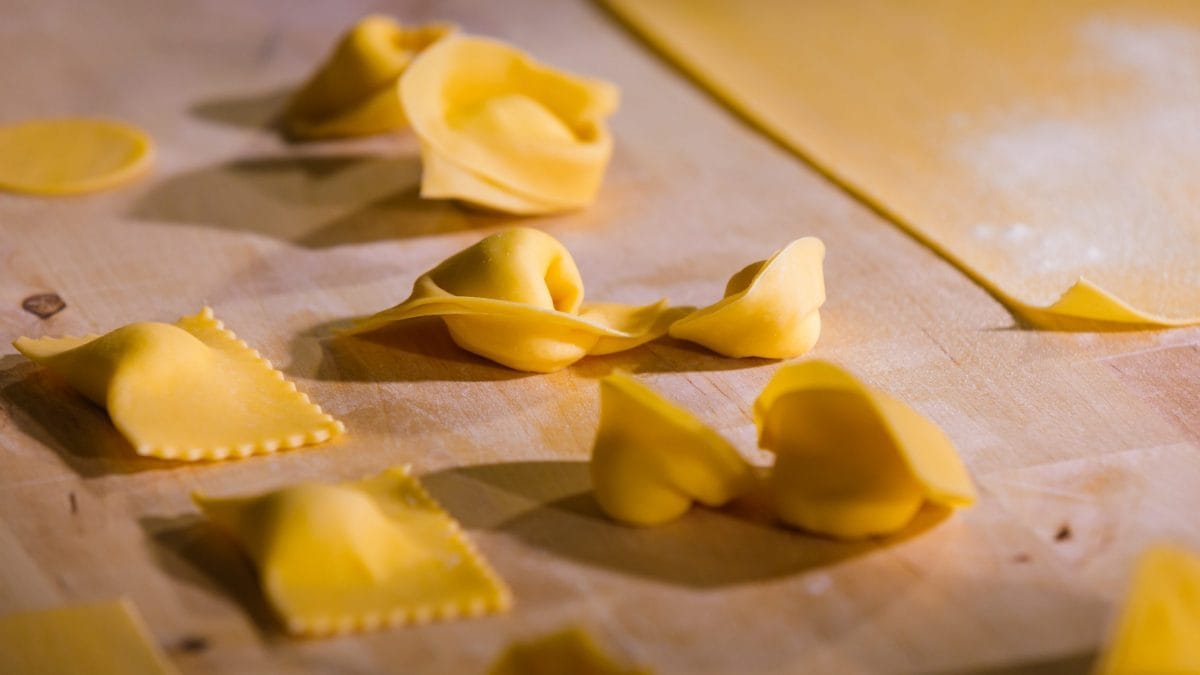
A virtual journey through Emilia Romagna in search of the sfogline, the tireless women who handcraft pasta following ancient traditions. In this region, fresh pasta is a religion, and every town has its own variations, secrets, and stories that are passed down orally from generation to generation, like ancestral myths.
So we decided to set out, to travel, to know. Not by hitchhiking but with our imagination: we catapulted ourselves into the region of Enzo Biagi, Lucio Dalla, Massimo Bottura, and Federico Fellini, along the Via Emilia to discover fresh pasta and the universe of recipes that revolve around it.
The History of Pasta in Emilia Romagna
We put on Spotify with Nino Rota's music and set off for Rimini, Fellini's very own city. Emilia-Romagna pasta is the nostalgia of a region that rejects the food industry and still dreams of a black-and-white future: with flour fluttering, whitening the pasta-making workers —the priestesses of food.
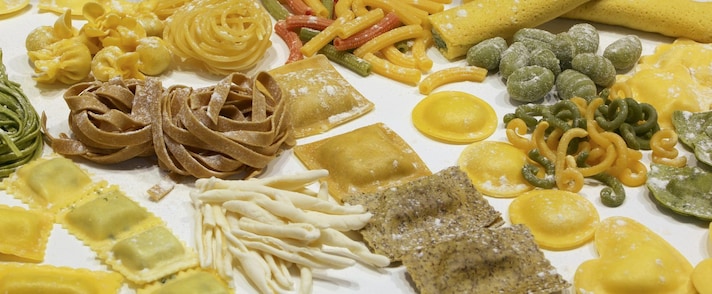
Unlike other regions, fresh pasta is still a cult here, its greatest expression being the ritual of rolling it out. Documented references to pasta date back to the 4th century BC, through the "De arte Coquinaria," which discusses Sicilian vermicelli and macaroni from the 15th century, and all the way to the industrial revolution that took place in Naples in the 17th century.
Amidst this hustle and bustle, there have always been the cities of the Via Aemilia —the road built by the Romans connecting Piacenza and Rimini—along with 36 types of pasta that we've fallen in love with and that we've selected. An itinerary that starts in Rimini and ends in Piacenza, covering 165 kilometers, which, when divided into the 36 pasta shapes, gives one shape every 4.5 kilometers: the Emilia-Romagna obsession.
Rimini's Orecchioni
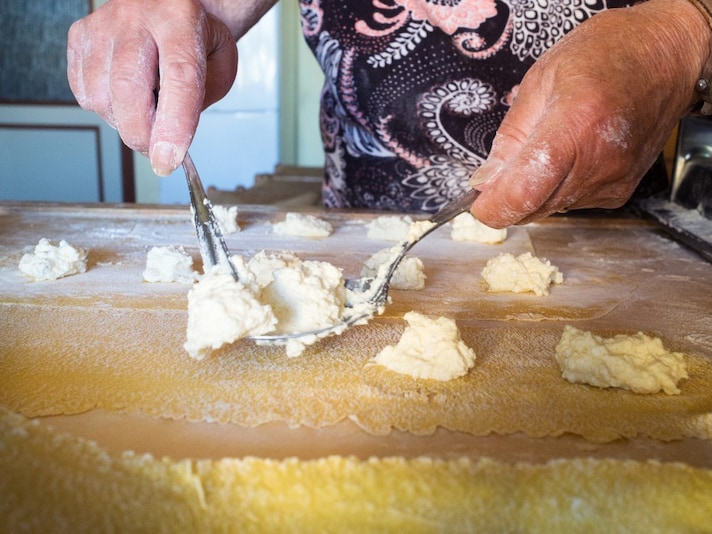
In the Italian capital of summer nightlife, we find orecchioni, also called urciòn in the Romagna dialect. They are the traditional first course of the holidays in Rimini. They are actually elongated ravioli. The traditional version of the Rimini filling is with meat sauce, but you should try the recipe with melted butter flavored with sage and seasoned with plenty of grated Parmesan: orecchioni buti e selva.
Cesena's Cappelletti, Ravioli and Green Lasagna
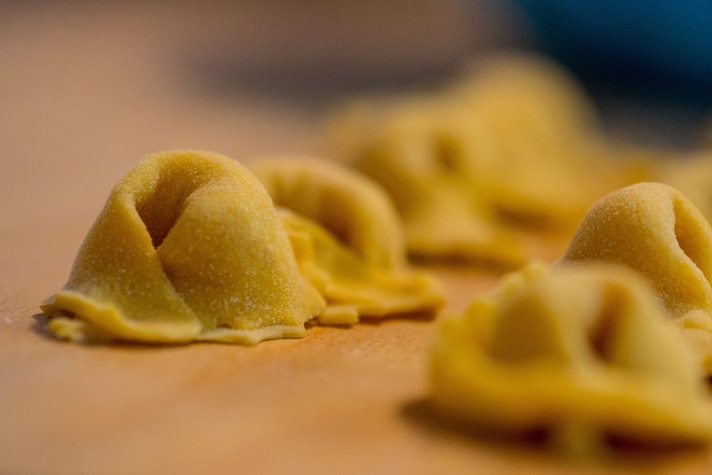
The second city on the Via Emilia, also in Romagna. If Rimini is linked to the history of cinema, Cesena is linked to the history of football because it is the birthplace of Arrigo Sacchi, a revolutionary. For lunch on our trip, we are spoiled for choice: cappelletti, ravioli, or the typical green lasagna; when in doubt, we order everything.
Cappelletti are a must-have on holidays and are made with squacquerone cheese, ricotta, parmesan, nutmeg, and grated lemon zest. Traditionally served in broth, a version with Bolognese sauce also became popular in the 1950s, thanks to the economic boom.
As for ravioli, here they are classic squares filled with spinach or wild herbs and ricotta; a simple, humble dish. Lasagna, on the other hand, is very distinctive, similar to other dishes from Emilia Romagna but with a green color due to the addition of spinach in the pasta, which gives it a unique flavor and appearance.
Forlì's Cappelletti Romagnoli
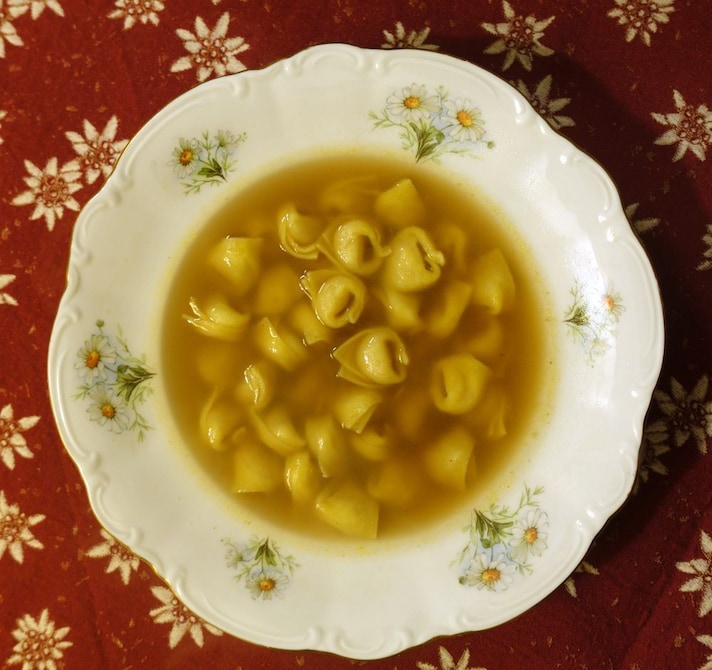
The city of Pellegrino Artusi is a cult place for any lover of Italian cuisine. Here we stop again for the cappelletti romagnoli. We rely on the maestro himself for the filling. In his "Science in the Kitchen and the Art of Eating Well," he lists cappelletti all'uso di Romagna, filled with ricotta (or ricotta and raviggiolo), capon breast, or pork loin, cooked in capon broth.
Faenza's Cappelletti
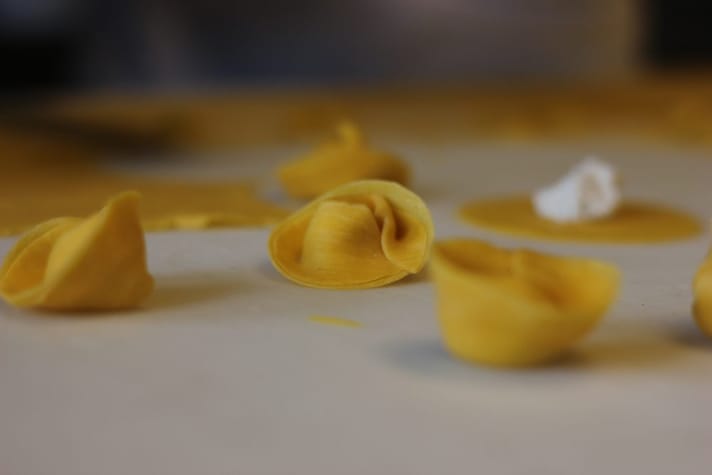
A short detour towards Ravenna. Before arriving in the capital, we stop in the Faenza area because we absolutely must try the meatless cappelletti. Faenza‘s typical fresh pasta is filled (batù) with soft cheeses, parmesan, and nutmeg, and is served exclusively in chicken broth.
Ravenna's Spoja Lorda
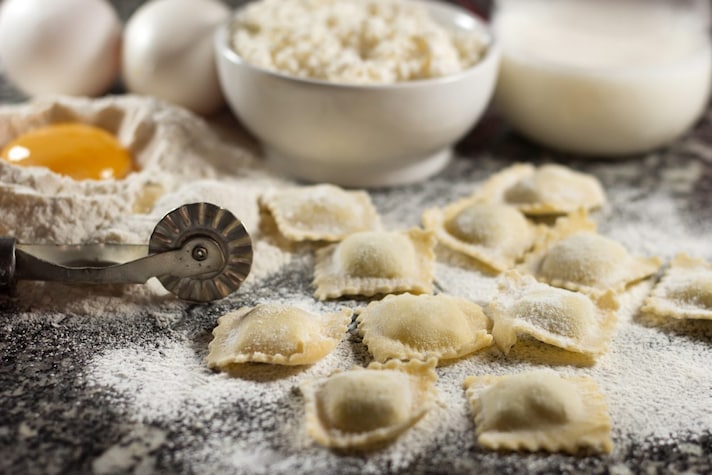
We arrive in the capital to try Romagna's quintessential soup: spoja lorda, literally "gross pastry." This dish originated in Brisighella, one of Italy's most beautiful villages, likely as a way to reuse unused cappelletti pasta. In the past, the filling for Romagna cappelletti was diluted with milk and spread over the pastry, which was then "grossed" by the filling. This fresh pasta is made with squacquerone, a mature cheese of your choice, eggs, nutmeg, and milk to make a creamy mixture. Spoja lorda and this cream, cooked together, are called "mnëstra imbutìda," or "stuffed soup."
Ferrara's Cappellacci and Caplit of The Este Family
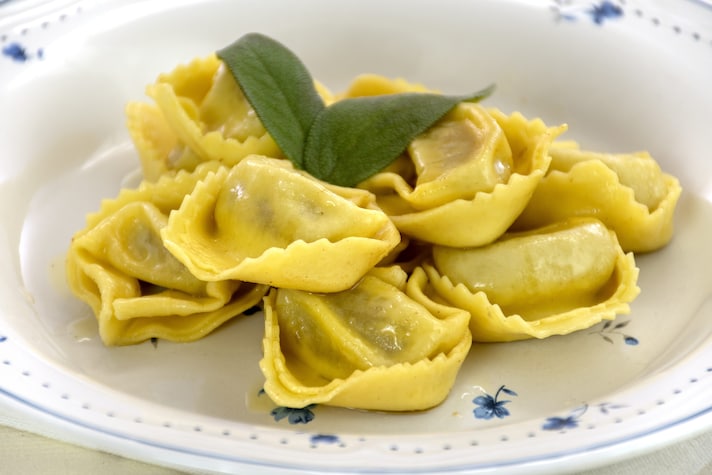
Before returning to the Via Emilia, we stop in Ferrara, a city with a very distinctive cuisine rooted in its history. Ferrarese cuisine is in fact influenced by Venetian cuisine thanks to the Este family, who ruled the city for much of its history.
Este cuisine covers everything from appetizers to desserts, and the most representative first courses, surprisingly, aren't made with fresh pasta. Ferrara's quintessential dish is the pasticcio di maccheroni alla ferrarese, a shortcrust pastry filled with macaroni, ragù, béchamel, and truffle. But fresh pasta is also a staple here, and in fact, we find cappellacci di zucca, also known as cappellacci estensi. The origins of this dish embrace the culinary tradition of stuffed pasta from Northern Italy and date back to a 1585 recipe by Giovan Battista Rossetti, chef during the reign of Duke Alfonso II d'Este.
Caplit, on the other hand, are Ferrarese cappelletti: similar in shape to other Romagna cappelletti, they differ in filling. Here we find pork, veal breast, salami, ground beef, mortadella, Parmesan cheese, and nutmeg. Some dare to use a mixture of Parmesan and Pecorino Romano, but traditionalists abhor this option.
Bologna's Multitude of Shapes
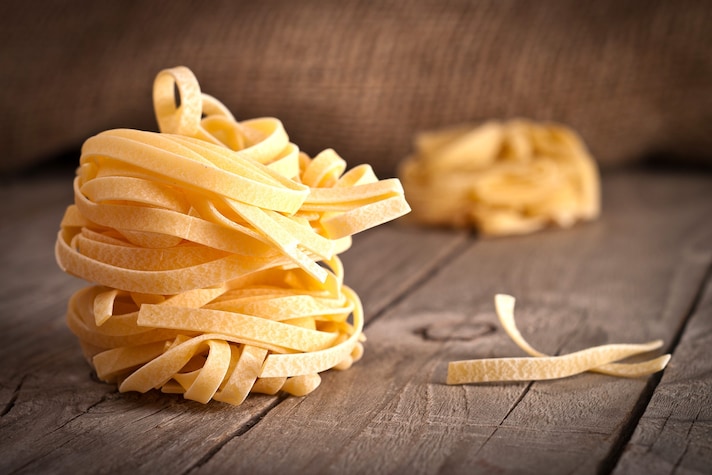
Leaving Ferrara, we return to the Via Emilia and arrive in Bologna. Here, Baggio rediscovered his goal-scoring skills and Lucio Dalla carved out pages of music history. When we stop to taste tagliatelle under the porticoes, the chant "Santi che pagano il mio pranzo non ce n'è sulle panchine in Piazza Grande" still rings out. Legend has it that this iconic pasta shape was inspired by the blond hair of the woman he loved.
Bologna's other typical and celebrated fresh pasta dish is lasagna. A sheet of almost transparent egg pasta filled with Bolognese ragù, ground beef, béchamel sauce, butter, and excellent Parmigiano Reggiano. The Emilian capital is so greedy that it even created a green version, with the same sauce but a spinach-filled dough.
The same green dough is also used for balanzoni, inspired by the local character Dr. Balanzone. Similar in shape to tortellini, but larger and more rounded, they are filled with spinach, mortadella, ricotta, and nutmeg, usually served with butter and sage. Traditionally eaten during Carnival, they are also called "tortelli matti" (crazy tortelli), because they were created to recycle leftover filling from the more famous tortellini. In Bologna, there is a true cult of "recycled" pasta shapes, and in addition to balanzoni, we find maltagliati and strichetti.
The former derives from tagliatelle because, when homemade, a small portion of the pasta dough is always left over, usually the edges, which are roughly cut to obtain deliberately uneven pieces of pasta, the so-called "mal-tagliati." The thickness also varies from one pasta to another, as it's the outermost layer of the pasta dough. The classic dish for using this pasta in Bologna is bean soup, but there are numerous recipes, mostly simple ones, that also include it.
Strichetti are the “cousins” of cappelletti: it often happened that the rezdore, the Emilian pastry chefs, would make large quantities of puff pastry to ensure they would use up all the previously prepared filling. Just as often, the filling would run out before the pasta, perhaps already cut into squares: to avoid throwing it away, strichetti were born. The name derives from the dialect word stichèr, meaning to tighten. The squares were pinched in the center to form a sort of pasta bow tie that could be enjoyed at will. They are the ancestors of farfalline.
Theoretically, the trip to Bologna would be over, but you'll say we forgot about tortellini. This is a very sensitive topic because there are two schools of thought: one says tortellino originated in Bologna, the other in Modena.
Modena's Tortellini and Other Shapes
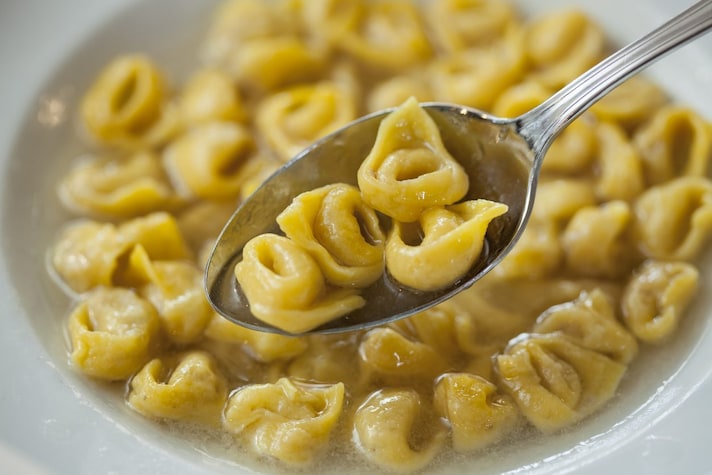
On this journey, we arbitrarily choose to assign tortellini to Modena. We do so because one of the greatest chefs in history has elevated tortellini to a haute cuisine dish. Bottura's tortellini gracefully stride across the broth, toward history: "For the people of Modena, a plate of tortellini never contains enough. So, I thought I'd draw attention to the quality of the pasta and filling by presenting six of them striding across a thin layer of capon broth, thickened with a touch of agar-agar. They would have been devoured with the same religious fervor reserved for an overflowing soup bowl," explains the chef of L'Osteria Francescana in the first episode of Chef's Table.
Even the most classic tortellini have a beautiful history, however: heirs to a long lineage of pasta created by the poor to recycle the meat of the rich, a bit like Neapolitan soffritto. The first mention of tortellini is even contained in a parchment dated 1112, but much more well-known is the legend of the innkeeper who, peeking through the keyhole of one of his guests' rooms, was so struck by the beauty of her navel that he wanted to reproduce it on a plate.
In Modena, in addition to tortellini, we find a whole range of other pasta varieties: tortelli, generally made with pumpkin, and tortelloni, larger and filled with ricotta. Then there's the long pasta, where tagliatelle leads the way. In Modena, the pasta dough is the same as in Bologna, but the ragù is different: it's made with mushrooms and wild boar or hare sauce. From the tagliatella sheets, the Modenese then made rosettes, mini sheets filled with cooked ham and cheese, then rolled into nests.
The two typical macaroni of the Emilian city are also rolled: al pettine and al torchio. The former are made by diagonally rolling a small square of puff pastry, the same size as tortellini, around a pencil-thin stick, then passing it over a weaving comb.
Tradition gives us the precise date of the birth of these macaroni: July 27, 1742, the day the fortress of Mirandola was besieged by the Savoy. The story goes that the king entered the fortress victorious and, with his Austrian ally Otto Ferdinand von Traun, went to eat at the inn. The siege had practically exhausted the food supplies, so the innkeeper prepared something with what was left: a puff pastry made with flour and eggs, topped with chicken meat. To best present the meager dish, he decided to roll the pasta squares onto a stick, then pass it over a screen to create the ridges.
Maccheroni al torchio, on the other hand, are ridged with a tool similar to a press and served with the ragù used for tagliatelle.
Reggio Emilia's Tagliatelle
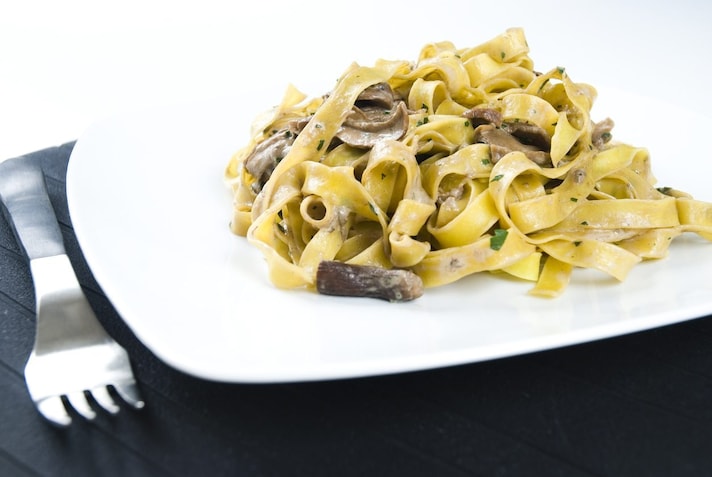
We move ever further north, arriving in the province of Parmigiano Reggiano. Few products in the world embody the aromas, flavors, and history of their land like Parmigiano. The tradition of making pasta in Reggio Emilia is very similar to that of Modena. The pasta shapes are almost all the same: tagliatelle, here topped with a mushroom ragù; cappelletti, traditionally eaten twice in a row, the first time in a bowl with a splash of wine added to the broth, the second time in a soup bowl with the cooking broth; and the classic lasagna.
A completely different type of pasta is the quadrettino: it is a small square of egg pasta cooked in meat broth and enriched with a small sauce, prepared separately, of poultry offal.
Parma's Tortel Dols and Anolini
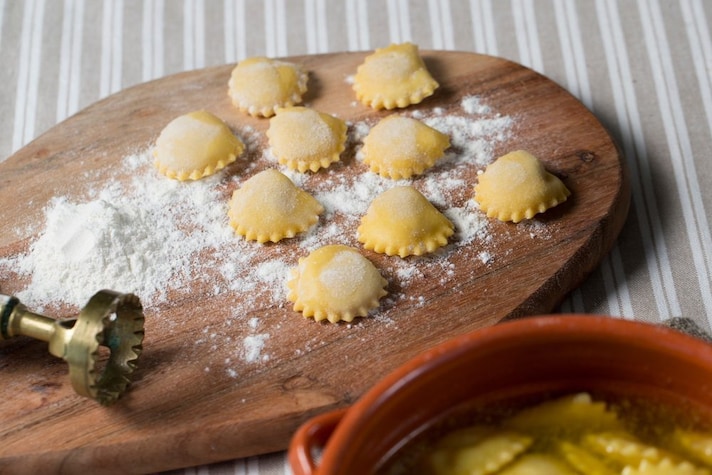
The 38 kilometers separating Reggio Emilia and Parma are enough to replace the playlist: from Lucio Dalla to Giuseppe Verdi. To the strains of Aida, we approach the Baptistery, along the streets that Bernardo Bertolucci traveled before us and that inspired him. The two-time Oscar-winning director is a connoisseur: food in his films is a sensual, symbolic, even political presence. His most irrepressible passion is for cured meats, which are omnipresent in his works: Pippo Campanini and Matthew Barry in La Luna have a magnificent culatello on the table; the New York actor, however, eats a plate of anolini.
This pasta is made with a filling sandwiched between two layers of pasta. It is an ancient shape, mentioned as early as 1284 and reintroduced to the popes and nobles of the Grand Duchy by Bartolomeo Scappi in 1500. The first "modern" recipe dates back to 1659, written by Ranuccio il Farnese, Duke of Parma, with parmesan and capon. In the following century, anolini conquered all of Italy, so much so that they became a favorite dish of Ferdinand of Bourbon, a king who made gastronomy a propaganda tool, even though, it seems, he continued to call them "raviuoli," like those produced in Naples.
The relationship between the Grand Duchy and the capital of the Kingdom of the Two Sicilies was not one of friendship, but of kinship: Maria Luisa of Habsburg, Duchess of Parma, was the niece of Maria Carolina, Queen of Naples. It is to the Duchess that we owe another typical Parma dish, tortel dols. It seems that Maria Luisa offered this sweet and sour dish to the boatmen of Sacca di Colorno as a sign of gratitude. The filling is made of breadcrumbs, cooked wine (made by slowly boiling grape must for 24 hours), and strictly homemade mustard.
Before leaving Parma and heading toward the end of our journey, we can't miss a dive into the world of tortelli, which here are green. The famous tortelli all'erbetta are made with a dough made from spinach or green chard, sometimes paired with herbs, seasoning, cheese, and ricotta. They are eaten on June 23rd in honor of St. John the Baptist, and tradition dictates that the tortelli be filled with a dough dominated by ricotta, while the amount of greens must be very limited to avoid being considered "rabbits."
Piacenza's Anolini
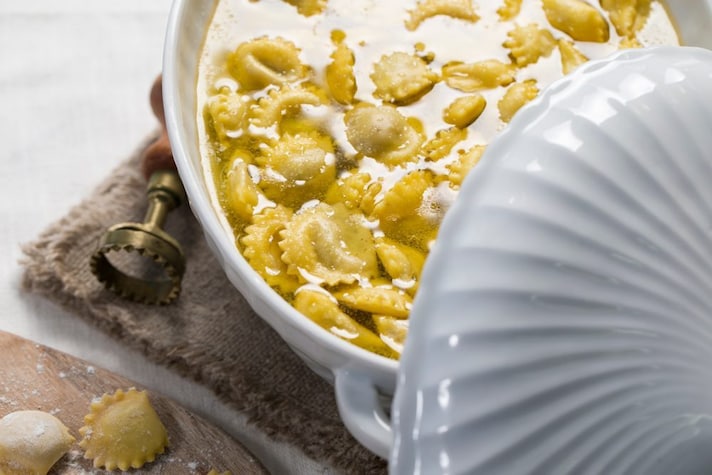
Yes, we encountered anolini in Parma because they are a specialty of the Grand Duchy, but in Piacenza there are several variations, and they shouldn't be underestimated. In addition to the traditional recipe shared by Parma, we find two other delicious versions: anolini anven and anolini alla bobbese. The former are a variation of the previous recipe, whose filling is made with parmesan, breadcrumbs, and nutmeg; the latter are derived from agnolotti pavesi, are larger and shaped like a small cap. Traditionally, they are served dry and topped with stew sauce.
“Alla bobbiese” we find two other formats created by the sfogline: lasagne and maccheroni. The former are traditionally prepared on Christmas Eve, but the recipe is very different from the Bolognese or Neapolitan version. This is a lean dish, seasoned only with béchamel sauce and composed of irregular, triangular or diamond-shaped lasagnettes, used as leftover pasta from the anolini pastry eaten at Christmas.
Macaroni, on the other hand, is pierced with a knitting needle and has medieval origins. This shape was first described in the "Liber de Arte Coquinaria" by Maestro Martino da Como, chef to the Patriarch of Aquileia in the 15th century. It is served with a sauce made from beef stew, chopped and shredded with a knife.
We conclude our journey into the world of tortelli with the Piacenza-style tortelli: they're shaped like sweets, with two tails on each side and a filling of ricotta, spinach, Grana Padano, nutmeg, eggs, and salt. They're traditionally served with melted butter, sage, grated Grana Padano, and a porcini mushroom sauce. Then there are the nettle tortelli, with a lean filling of ricotta, nettles, nutmeg, and Grana Padano. Finally, there are the chestnut flour tortelli, the humble version of the Piacenza-style tortelli.
The End of The Journey
This journey through Italy's history, with its dukes, princes, directors, musicians, and football stars, concludes with a humble dish like chestnut tortello. A world encompassed in just 165 kilometers, it speaks to Italy's riches, its nuances, and the coexistence of the art of making do with opulent dining.
;Resize,width=767;)
